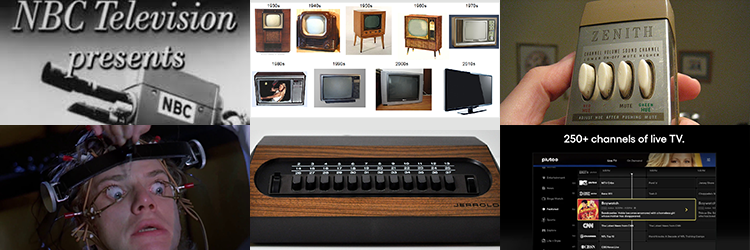This is my effort to break down some of the oft-repeated assumptions that people are now making about the future of content delivery and to offer a few facts that might just take their place.
The three columns this week:
Assumptions - Episode One: Theatrical, An Old Hope
Assumptions - Episode Two: Linear Television, Decision-Free Strikes Back
Assumptions - Episode Three: Streaming, Return of the Bundle
I grew up changing the channels of our giant 20-inch screen by hand. Sound too. The closest we got to Alexa was in 1981 when Alexis Carrington Colby came into our lives.
The great irony is that, in spite of the small screen, the bad sound, and the lack of content options, watching TV in the pre-cable era was more like watching a movie in a movie theater because that little box commanded our attention with an exclusivity that it now a challenge in any household, no matter how big your TV or how good your sound.
When you turned it on… it was on. You could get up and change the channel. But mostly, you did not. Maybe at the hour. But if you had a hit show at 10, you were setting up the local stations of your network for huge numbers for their 11p (10p central) news. And at 11:30, it was Johnny or bust until the Ayatollah Khomeini greenlit Nightline on ABC in 1979.
Things have changed. A lot. But not quite as much as a lot of people seem to believe.
Assumptions, Episode Two: Linear Television
1. No one watches traditional television anymore.
Simply false. Current analysis is that cable/broadcast still enjoys more than double the total screentime than streamers in America.
We can still point to singular events in both streaming and legacy. For instance, the #1 domestic cable/broadcast TV show is Yellowstone with domestic viewership of about 104 million hours or 6.2 billion minutes.
Netflix’s Squid Game, their #1 show last year, beat that handily, with domestic viewership of about 285 million hours or 15.5 billion minutes.
The Paramount Network, which is where Yellowstone launches, has 80 million accessible households in the U.S. Netflix has 74 million. So it’s a fair fight that way. But as even Paramount Network fans will acknowledge, Netflix has a much higher engagement level amongst their subscribers.
Still, people are watching boring old television (broadcast/cable/satellite) and have not abandoned it.
Unfortunately, there is no apples-to-apples comparison really possible internationally. I think there will be in a 5 years or so… but it’s going to take a lot of international growth from Netflix’s competition.
2. The advertising-based model of delivering content is on its way out.
Right now, the hottest area of growth in streaming is advertising-based models. HBO Max launched theirs. Peacock and Paramount+’s are both growing faster than their paid/no-commercials models.
Broadcast TV is still getting $160k - $600k per minute in prime time, non-football.
Overall television advertising revenues added up to about $81 billion in 2021.
AVOD (ad-based streaming) seems to have generated somewhere between $5 billion and $6 billion last year.
3. The average household is willing to spend more each month for more content.
Historically, this is false. If you look at the history of Home Entertainment, the rise of DVD and rising cable prices did happen together in the early 2000s, raising the average amount people were spending at home for filmed entertainment.
However, during the streaming rise of Netflix, there was an almost perfect correlation between people spending more on streaming and less on DVDs (aka physical media). For every billion in revenues that Netflix added, Physical Media lost another billion.
Obviously, these are not coordinated efforts. But most people have budgets and they know exactly what they are spending each month and adjust accordingly. The history suggests that the tendency is to replace, not add, if the monthly expense will get bigger.
Recent growth in AVOD suggests that people want the tools that streaming offers, but that they are being more careful than you might expect in adding to their monthly household costs.
Realities
1. Traditional Television, via Broadcast & Cable, continue to dominate screentime.
As the world seems to turn to a “what is a channel?” universe, a new Nielsen product, The Gauge, embraced by Reed Hastings of Netflix, is reminding everyone that, in the great tradition of Monty Python, TV, as we have known it for the last 4 decades, is not yet dead. (Hat tip to Andrew Rosen for pointing to this and to Reed Hastings embrace of it.)
For all the massive numbers we keep hearing about Netflix and other streamers, the first 8 months of “The Gauge” put Cable and Broadcast TV at anywhere between 62% and 65% of the overall screentime of Americans.
“During the week of Christmas, Americans watched a total of 183 billion minutes – an all-time high.”
This chart suggests that Americans watched 1.93 billion hours of cable/broadcast that week. That is about 4.4 hours a day per household (corded or not).
That would translate to a daily average of 2.8 hours of broadcast/cable, 1.2 hours of streamers, and 24 minutes of “other.”
It seems obvious that this will not go on forever. Streaming will become dominant. But what is unclear is what the tipping point will be for people to make the leap from their cable/satellite bills, which have become excessive - you know all the complaints - to streaming.
2. The streaming industry has not delivered a coherent argument to convince the majority of American households to dump their cable/satellite subscriptions.
About 70 million U.S. households still pay for cable or satellite (MPVDs).
Another 7.5 million currently subscribe to virtual cable (vMPVDs).
That’s about 70% of the 110 million estimated total count of U.S. households.
Now… 77.5 million is down from 90 million cable/satellite households in 2018. So there have been significant erosion. But most projections were that this would go much faster.
What’s the hold up?
I would argue that competition and the intense, relentless focus on individual platforms adding subs has meant that the public is not being pitched on why they should cut the cord.
The Pitch
1. Here is what you need in your home to make this transition
2. Here is the minimum home internet level you need in your home to run a TV, 2 computers, and 2 phones.
3. Here is how you check to make sure that an vMPVD (virtual cable) has all the channels you still want from your cable experience.
4. Benefits include: no hardware from your content provider, reliable virtual DVR, shared experience across multiple TVs at no extra charge.
5. It costs less.
A serious sales effort would have to include explaining to consumers how to read their monthly bill, separating the content fees vs the home internet fee (often on the same bill) so they can realistically figure out how much they might save. $30 - $50 a month is not an unusual amount of savings.
One of the problems, particularly in Los Angeles, is that local sports teams have been allowed by the FCC to appear on local/regional sports networks which have demanded so much in fees that some cable/satellite and virtual cable, that many have refused to have these teams on their system. So people stick with the cable that has their favorite team.
For the sake of this exercise, I will use my own set-up as an example.
I pay $70 a month for fiber optic home internet service. And if I had cable or satellite, I would be paying for home internet service. It is the equivalent of having a home phone in the olde days.
I pay $65 a month for the base plan with YouTubeTV, which allows up to 3 streams at a time and allows you to include up to 5 family members on your service.
HBO Max/HBO - $15
Showtime - $11
Starz - $9
Epix - $6
With DirecTV, it’s pretty much the same basic channels, plus HBO, Showtime, Starz for $135 a month in the first year and over $200 a month in Year Two. Epix isn’t available.
So to start, it’s $118 for YouTubeTV vs $135 for DirecTV. But that doesn’t include all the little upcharges you get with DirecTV or cable companies… like for $5 for every extra box beyond the 1st or even HD. But that $17 difference, which is really a $50 difference leaps to over a $125/mo difference in Year Two.
I tried to do this analysis for Spectrum, but I don’t have the knowledge of the product. Looking around the web, a similar pricing bait and switch seems to be in play.
In any case, my point is that it is in the interest of all streaming content companies to get those cords cut as quickly as possible because the sooner those monthly funds are not going to the most expensive delivery platforms, the sooner those dollars can be reassigned to additional streamers.
3. Reliable high speed internet is enormously critical to the cord cutting future
Besides a great pitch for cord cutting, there is still a problem with the quality of internet access in a high percentage of American homes.
One of the big problems with “high speed internet” statistics is that the definitions are blurry. “Under FCC regulations, broadband must have download speeds of at least 25 megabits per second and upload speeds of at least 3 megabits per second to be considered broadband.”
So most of America has “broadband” and President Biden is working to close the gap for those who do not. However, 25 mbps is really not enough to cut the cord and get service on the same level of cable or satellite.
More than 1/3 of Americans are estimated to not have access to “high speed” internet service, at any price. What exactly is “high speed?” Unclear.
For me, the minimum speed of your home internet access to make cutting the cord viable is 100 mbps. A decent level starts at 200 mbps. Things are good at 300 mbps. And the ideal is fiber optic, which is 1000 mbps.
Many of the early cord cutters were not particularly choosey about their home internet connections. They felt screwed over by cable/satellite and wanted out. A good antenna (now the norm and cheap), DVDs, YouTube, paid content, and, sadly, piracy became their friends.
Remember, it took more than 10 years for reasonably priced wireless phones to become ubiquitous. And we all remember the growing pains… oh, those surprise $400 bills!!! There are still people without wireless phones, but having a phone is the norm. And smartphones in most cases.
In the transition to the streaming world, the young ones have come up with all kinds of new unexpected habits. But remember… we are still early in the process and they are all going to keep getting older. Things change. They won’t be watching everything on their phone forever.
I was shocked to find that a friend in the valley, not 5 miles from Warner Bros, was on a home internet plan from AT&T at 3 mbps. And that was they best they could offer. I switched her to Spectrum and a 300 mbps package for about the same price. But she just figured that spinning circle was part of the process. And this is a smart person.
People want not to think about this a lot. They don’t want to keep switching apps. They don’t want to have to try to find a show they heard about across a series of streamers… or really, even searching within a streamer. They want to turn on the TV and watch what they want without thinking too much. That’s human nature. In every era.
Quality internet service for almost everyone is the first key before we get to all of these companies ceasing fire long enough to make their customers happier in engaging all of their shows. Can’t come soon enough.
Until tomorrow…















